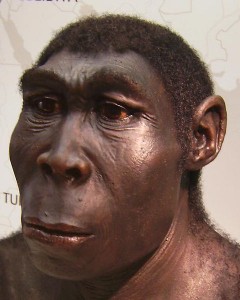An international team of scientists claim that their recent research could rewrite the history of human evolution.
The researchers suggest that instead of our early human ancestors belonging to different evolutionary species such as Homo habilis, Homo rudolfensis or Homo erectus, they are all actually of the same species, but just happen to look a bit different from each another.
Writing in the journal Science, the scientists from Georgia, Switzerland, Israel and the U.S. came to their conclusions after studying a 1.8-million-year-old skull from the early Pleistocene epoch that was unearthed in Dmanisi, Georgia.
According to the researchers, the skull they studied, called Skull 5, is not like other fossils of the Homo genus. Skull 5, they said, reveals a combination of a braincase that’s about 546 cubic centimeters along with a long face and large teeth.
Despite having limb proportions and the body size of a modern human, the researchers said that the small braincase of Skull 5 indicates that this early human ancestor had a small brain.
The skull was found with the remains of four other human ancestors along with other material that included an assortment of animal fossils and some stone tools.
The researchers said this was a unique find since all of the unearthed material could be associated with the same time period and location.
In examining and analyzing “Skull 5”, the researchers said that they found that the differences between the various fossils were no more noticeable than those between five modern humans or five chimpanzees.
“Had the braincase and the face of Skull 5 been found as separate fossils at different sites in Africa, they might have been attributed to different species,” said Christoph Zollikofer from the Anthropological Institute and Museum in Zurich, Switzerland and a co-author of the report. “That’s because Skull 5 unites some key features, like the tiny braincase and large face, which had not been observed together in an early Homo fossil until now.”
Researchers previously have typically considered variations among Homo fossils as an indication that they were of different species.
But those involved with this recent study say that their findings suggest that fossils of various early members of the human family, all originating in Africa, are part of one evolving lineage, probably what is known as Homo erectus. Previous research indicates that this now extinct hominid lived as recently as 143,000 to about 1.8 million years ago.

Study suggests that other human ancestor species may actually belong to the species Homo erectus seen here in this reconstruction. (Westfälisches Landesmuseum via Wikimedia Commons)
“[The Dmanisi finds] look quite different from one another, so it’s tempting to publish them as different species,” explained Zollikofer. “Yet we know that these individuals came from the same location and the same geological time, so they could, in principle, represent a single population of a single species.”
Checking the African fossil record, the researchers said that they also noticed a similar pattern and range of variation in the African fossil record so they figured that it was safe to assume that there was a single Homo species at that time in Africa too.
Furthermore, the researchers also found that since the hominid fossils recovered from the Dmanisi site are so similar to those found in Africa, they theorize that they are also both of the same species.
While the Georgian dig site is already providing opportunities for researchers to “compare and contrast” the physical characteristics of a number of human ancestors that happened to be in the same place and time, scientists expect even more evidence to be uncovered, since the site has only been partially excavated.























Isn’t that what anti-evolutionists have said for decades: evolution within species, but not across phyla?